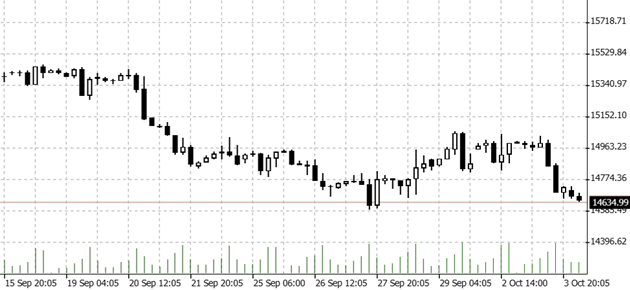

04.10.2023 – The interest rate scare is back: interest rates on U.S. government bonds are rising. The Federal Reserve is also pouring oil on the fire. And the U.S. jobs market is hotter than expected.
The past two days brought heavy warning shots for the bulls. No wonder, for example, the Nasdaq 100 dipped, shown here on the four-hour chart.

Source: Bernstein Bank GmbH
U.S. bonds, in particular, worried investors. For example, the yield on the ten-year T-note just marked a 16-year high of 4.802 percent. And interest rates on the thirty-year Treasury bond also climbed to 5.011, the highest level since 2007.
Bond sell-off
This means that investors are selling existing bonds until the yield reaches the expected level of new bonds to be issued. Since there are more attractive coupons on new bonds than on current issues when the prime rate is higher, existing bonds become less attractive. In addition, large counterparties interested in reliable coupon payments – such as pension funds or insurance companies – divert money from the equity market to the bond market when interest rates rise.
JPMorgan Asset Management warned that there is a risk of further sell-offs in the equity market: “We have not anticipated such an increase in rates. This is something which will at least slow down, or even reverse the progress of equity markets,” judged analyst Vincent Juvyns.
Hot job market
The JOLTS report – the acronym stands for Job Openings and Labor Turnover – also gave fodder to the bears. For example, the number of job openings rose again after previously falling for three months in a row. The Labor Department registered 9.6 million job openings in August, up from 8.9 million in July. Most analysts had expected a decline to 8.8 million.
The report raises the risks of more rate hikes – as the Fed fears a wage-price spiral in its fight against inflation. “The Fed won’t make policy decisions based on one JOLTS report, but it does keep the risks tilted toward another rate hike,” judged Nancy Vanden Houten, an economist at Oxford Economics.
Warnings from the Fed hawks
Already on Monday, Loretta Mester, head of the Cleveland Fed, expressed herself accordingly. She said, “I suspect we may well need to raise the fed funds rate once more this year and then hold it there for some time.” Atlanta Fed President Raphael Bostic said the Fed still has a long way to go on inflation, and he, too, wants to keep rates higher “for a long time.” In addition, Governor Michelle Bowman pushed for multiple rate hikes.
Higher interest rates make it more expensive for businesses to borrow, which ultimately lowers profits and thus weighs on stock prices. According to “Barchart.com,” the market now sees a 31 percent chance that the Fed will raise rates by 25 basis points at its Nov. 01 meeting. In addition, another 52 percent chance for another 25 basispuntke for the December 13 meeting. Only from the second half of 2024, the central bank would lower interest rates again because of a possible economic weakness.
We continue to keep an eye on the situation on the interest rate front for you – Bernstein Bank wishes successful trades and investments!
___________________________________________________________________________________________________________________________________________________________________________________________________
The content of this publication is for general information purposes only. In this context, it is neither an individual investment recommendation or advice nor an offer to purchase or sell securities or other financial products. The content in question and all the information contained therein do not in any way replace individual investor- or investment-oriented advice. No reliable forecast or indication for the future is possible with respect to any presentation or information on the present or past performance of the relevant underlying assets. All information and data presented in this publication are based on reliable sources. However, Bernstein Bank does not guarantee that the information and data contained in this publication is up-to-date, correct and complete. Securities traded on the financial markets are subject to price fluctuations. A contract for difference (CFD) is also a financial instrument with leverage effect. Against this backdrop, CFD trading involves a high risk up to the point of total loss and may not be suitable for all investors. Therefore, make sure that you have fully understood all the correlating risks. If necessary, ask for independent advice. CFDs are complex instruments and are associated with the high risk of losing money quickly because of the leverage effect. 68% of retail investor accounts lose money trading CFD with this provider. You should consider whether you understand how CFD work and whether you can afford to take the high risk of losing your money.7
